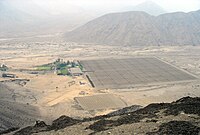
Photo from wikipedia
Abstract. In recent years, multistatic specular meteor radars (SMRs) have been introduced to study the Mesosphere and Lower Thermosphere (MLT) dynamics. In this paper, the statistics of mesoscale MLT power… Click to show full abstract
Abstract. In recent years, multistatic specular meteor radars (SMRs) have been introduced to study the Mesosphere and Lower Thermosphere (MLT) dynamics. In this paper, the statistics of mesoscale MLT power spectra are explored through observations from a campaign using the SIMONe (Spread-spectrum Interferometric Multistatic meteor radar Observing Network) approach conducted in northern Germany in 2018 (hereafter SIMONe 2018). The seven-day SIMONe 2018 comprised of fourteen multistatic SMR links and allows to build a substantial database of specular meteor trail events, collecting more than one hundred thousand detections per day within a geographic area of ~ 500 km x 500 km. The two methods we propose to obtain the power spectra in frequency range are (1) Wind field Correlation Function Inversion (WCFI), which utilizes two-point correlations of specular meteor observations, and (2) Mean Wind Estimation (MWE), which determines the MLT winds and gradients from specular meteor observations. Monte Carlo simulations of a gravity wave spectral model were implemented to validate and compare both methods. The simulation analyses suggest that the WCFI is the viable option among them to study the second-order statistics of the MLT winds that helps to capture the energy of small-scale wind fluctuations. Characterization of the spectral slope at different MLT altitudes has been conducted on the SIMONe 2018, and it provides evidence that gravity waves with periods smaller than seven hours and greater than two hours are dominated by waves with horizontal wavelength significantly larger than 500 km, which might be associated to secondary gravity waves. We believe that the presented methods can help us bridge the observational gap between large and small-scale mesospheric wind fluctuations and also improve the capabilities of SMRs.
Journal Title: Atmospheric Chemistry and Physics
Year Published: 2020
Link to full text (if available)
Share on Social Media: Sign Up to like & get
recommendations!